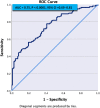Night-Time Non-dipping Blood Pressure and Heart Rate: An Association With the Risk of Silent Small Vessel Disease in Patients Presenting With Acute Ischemic Stroke
- PMID: 34867710
- PMCID: PMC8637909
- DOI: 10.3389/fneur.2021.719311
Night-Time Non-dipping Blood Pressure and Heart Rate: An Association With the Risk of Silent Small Vessel Disease in Patients Presenting With Acute Ischemic Stroke
Abstract
Background and Purpose: Nocturnal non-dipping blood pressure and heart rate are associated with an increased risk of cardiovascular disease. The effects of such variance on cerebrovascular disease have not been well studied. Methods: The 24-h ambulatory blood pressure (ABPM) and heart rate were monitored with B-pro in patients with acute stroke within the initial week of hospital admission. The risk factor profiles, clinical presentation, imaging, and short-term prognosis were compared in nocturnal dippers and non-dippers (more than 10% nocturnal decrease) of blood pressure and heart rate. Results: We enrolled 234 patients in whom ABPM and MRI data were available. Heart rate data were available in 180 patients. Lacunar sub-cortical stroke was the most common acute lesion (58.9%), while hypertension (74%) and diabetes (41.5%) were the most common associated risk factors. ABPM revealed non-dipping in 69% of patients. On univariate analysis, Small Vessel Disease (SVD) was significantly more frequent in non-dippers vs. dippers (BP: 56.8 vs. 40.3% p = 0.02; heart rate: 57.9 vs. 40.7% p = 0.03). Silent strokes were also more frequent in non-dippers vs. dippers (BP: 40.7 vs. 26.4% p = 0.35; heart rate: 44.6 vs. 25.4% p = 0.01). Multivariate analysis revealed SVD to be significantly related to age, hypertension, blood pressure non-dipping, and severity of symptoms at index event. Conclusions: The presence of nocturnal non-dipping of blood pressure and heart rate are associated with an increased risk of silent stroke and SVD. Increased use of ABPM may allow for improved diagnosis of non-dippers.
Keywords: ischemic stroke; night-time non-dipping; outcome; small vessel disease; stroke severity; stroke types.
Copyright © 2021 Akhtar, Al-Jerdi, Kamran, Singh, Babu, Abdelmoneim, Morgan, Joseph, Francis and Shuaib.
Conflict of interest statement
The authors declare that the research was conducted in the absence of any commercial or financial relationships that could be construed as a potential conflict of interest.
Figures
Similar articles
-
Midday Dipping and Circadian Blood Pressure Patterns in Acute Ischemic Stroke.J Clin Med. 2023 Jul 21;12(14):4816. doi: 10.3390/jcm12144816. J Clin Med. 2023. PMID: 37510931 Free PMC article.
-
Stroke prognosis and abnormal nocturnal blood pressure falls in older hypertensives.Hypertension. 2001 Oct;38(4):852-7. doi: 10.1161/hy1001.092640. Hypertension. 2001. PMID: 11641298
-
Nocturnal blood pressure dipping in acute ischemic stroke.Acta Neurol Scand. 2015 Nov;132(5):323-8. doi: 10.1111/ane.12402. Epub 2015 Mar 24. Acta Neurol Scand. 2015. PMID: 25809341
-
[Blood pressure variation and cardiovascular risk in hypertension].Nihon Rinsho. 2004 Nov;62(11):2145-56. Nihon Rinsho. 2004. PMID: 15552901 Review. Japanese.
-
Nighttime dipping status and risk of cardiovascular events in patients with untreated hypertension: A systematic review and meta-analysis.J Clin Hypertens (Greenwich). 2020 Nov;22(11):1951-1959. doi: 10.1111/jch.14039. Epub 2020 Nov 8. J Clin Hypertens (Greenwich). 2020. PMID: 33164307 Free PMC article.
Cited by
-
The heart rate non-dipping pattern was associated with target organ damage in patients with chronic kidney disease.Int Urol Nephrol. 2024 Oct;56(10):3381-3388. doi: 10.1007/s11255-024-04095-5. Epub 2024 Jun 3. Int Urol Nephrol. 2024. PMID: 38829465
-
Sex Differences in 90-Day Functional Outcomes for Acute Ischemic Stroke Patients With Obstructive Sleep Apnea.Cureus. 2023 May 29;15(5):e39652. doi: 10.7759/cureus.39652. eCollection 2023 May. Cureus. 2023. PMID: 37388591 Free PMC article.
-
Data lake-driven analytics identify nocturnal non-dipping of heart rate as predictor of unfavorable stroke outcome at discharge.J Neurol. 2023 Aug;270(8):3810-3820. doi: 10.1007/s00415-023-11718-x. Epub 2023 Apr 20. J Neurol. 2023. PMID: 37079032 Free PMC article.
-
The Association of Nocturnal Blood Pressure Patterns and Other Influencing Factors With Lacunes and Enlarged Perivascular Spaces in Hypertensive Patients.Front Neurol. 2022 May 23;13:879764. doi: 10.3389/fneur.2022.879764. eCollection 2022. Front Neurol. 2022. PMID: 35677332 Free PMC article.
-
Clinic and ambulatory blood pressures, blood pressure phenotypes and mortality in patients with a previous stroke.Hypertens Res. 2024 Sep;47(9):2503-2510. doi: 10.1038/s41440-024-01760-1. Epub 2024 Jun 25. Hypertens Res. 2024. PMID: 38918531
References
LinkOut - more resources
Full Text Sources


